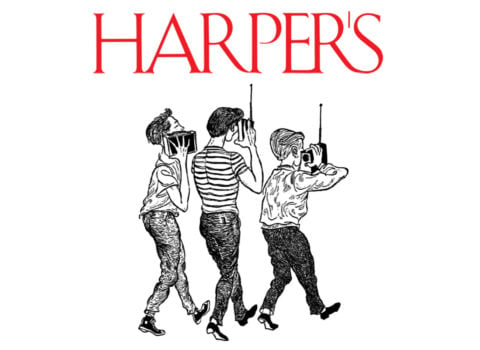Some of the most interesting minds at work in the American arts today can be found in the video-game industry. Such designers as Jonathan Blow, Jenova Chen, Clint Hocking, Ken Levine, Jason Rohrer, and Kellee Santiago all aspire to an imaginative excellence most novelists, visual artists, and filmmakers would recognize instantly. But whereas most people have a ballpark conception of what it means to be a film director or a painter, hardly anyone can tell you the first thing about what it’s like to make a video game.
Austin Grossman attempts to remedy this with his second novel, You (Mulholland Books, $25.99), which concerns a (fictional) middling 1990s video-game company called Black Arts. This is familiar territory for Grossman, who has worked in and out of the games industry for the past twenty years. His ingenious first book, Soon I Will Be Invincible, depicted a world filled with superheroes and villains, but its integument was that of a psychologically observant literary novel. With You, Grossman is, once again, crossing the streams of his putatively adolescent and adult fascinations.
Desperate for a career do-over, Russell, the narrator, comes to work at Black Arts as a twenty-eight-year-old failed journalist. (Two of Russell’s childhood friends founded the company.) Grossman was born in 1969, the same year as his narrator, which allows him to write evocatively about the “floods of quarters warmed with adolescent body heat” and the sense all young gamers had of being “dimly aware that we were the first people, ever, to be doing these things.”
After only a few weeks at Black Arts, Russell is unexpectedly promoted to lead game designer for the company’s next title. His thoughts on making and playing games (“we had all the problems of shooting a movie while simultaneously inventing a completely new kind of movie camera and writing the story for a bunch of actors who weren’t even going to follow the script”) form the core of You, giving Grossman the occasion for some of the most startling, acute writing on video games yet essayed.
As a piece of straight-up fiction, however, You is not always successful. Video-game characters, Grossman writes, are “paper-thin, just empty things you steered around the world to get what you want,” and this seems dismayingly applicable to some of the people we meet in the novel. Russell’s blandness as a character may be inevitable (he spends most of the book sitting in front of a computer screen, after all), but the people who drift into his orbit also tend to be types of a single — and not particularly memorable — note. Thus when the emptily iconic characters from Black Arts’ story lines begin to invade Russell’s dreams and give him advice, you pay attention. That a wizard rendered in pixels upstages characters of ostensible flesh and blood is either Grossman’s sly commentary on games or his unwise surrender to them.
You’s plot turns on a piece of baleful code implanted deep within the engine that powers all of Black Arts’ games; how this bit of digital malevolence embodies itself, and what it does, is both upsetting and amusing, as is Russell’s half-ridiculous, half-profound, and highly Platonic explanation of why any of us play video games in the first place:
To forestall any future threat, the gods decreed we should each be separated into halves, and each half hurled into a separate dimension. There was a human half, weak but endowed with thought and feeling, and a video game half, with glowing and immortal bodies that were mere empty shells, lacking wills of their own. We became a fallen race, and forgot our origins, but something in us longed to be whole again. And so we invented the video game, the apparatus that bridged the realms and joined us with our other selves again.
Everything in Austin Grossman’s novel feels urgently defined by our digital era. Benjamin Lytal’s debut novel A Map of Tulsa (Penguin, $15), conversely, could have been written twenty — even fifty — years ago. Its first and second halves take place during the Clinton and Bush Administrations, respectively, and contain several mentions of email; beyond that, the novel’s concerns seem curiously unstuck in time.
Lytal’s narrator, Jim, is an aspiring poet. He’s back home for the summer, after his freshman year at an elite (presumably Ivy League) college. He’s returned to Tulsa to prove to himself “that it was empty.” What he finds instead is a young woman named Adrienne Booker: high school dropout, heir to the Booker Petroleum fortune, diligent painter, and resident of a skyscraper penthouse. Jim and Adrienne’s relationship begins with some mild drug use and frottage before lurching into a creepily detailed ménage à trois, at which point the novel begins to shake and rumble like a small, unexpectedly powerful volcano.
A “clearly aristocratic” young woman like Adrienne, “a blond genius with long legs and a paintbrush,” is bound to compel the average reader to wonder whether she is encountering a plausible character or rather stepping into some exotic game preserve. This is probably why Lytal brings Adrienne down to earth with a broken nose and no great knowledge of painting; why, during a painful scene in which Jim introduces her to his schoolteacher parents, he has the private wish that Adrienne were more “explosively beautiful.” She senses Jim’s disappointment and chastises him for it on the way home: “You acted like you were ashamed of me.” He is, of course. Intelligent but unschooled, sociable but self-centered, Adrienne is, for Jim, an explicit repudiation of his careful life, with its “special little record of achievement.”
That young Americans love the wrong people hard and recklessly is no one’s idea of news, but it’s not the what of this novel — of any fine novel — that stays with you. Begin with the prose. A novel written in the voice of a purported poet had better be fortified with luxurious images, and A Map of Tulsa prodigally provides them. Jim sees a city skyline as “battleships, bristling with darkness,” and likens an English saddle to a “strenuous black tongue.” Lytal is brilliant on how intimacy feels (“To be in the same warm bed with her was like a lightbulb turned on in my stomach”) and at conveying sensory information. For instance, inside a parking garage, “there was a drip someplace, far away, all around us” — ten words, none of which is “echo,” and yet how gorgeously he evokes that drip’s hollow, echoey plink. Lytal is equally skilled at putting together brokenhearted aphorisms: “An ex-girlfriend, by definition, is a memory improperly possessed.”
A Map of Tulsa deserves comparison with the very best novels of its kind, from James Salter’s A Sport and a Pastime to Scott Spencer’s Endless Love. It’s also one of the most insightful books about the comforts (and traps) of small-city parochialism I’ve ever read.
I could not take an interest in motorcycles, the art world, or Italian radicalism if I were paid to in large, recurring installments, but Rachel Kushner’s second novel, The Flamethrowers (Scribner, $26.99), which is about motorcycles, the art world, and Italian radicalism, has made me care about these things deeply. The power of fiction is not so different from what Austin Grossman believes to be central to the experience of video games: the sudden sense you get that you’ve been cleaved from some calamitously lost other half. Seeing the world through another’s eyes, you are restored to what feels like full sight, and full thought, once again.
Here is the kind of book that reminds you how emotionally refurbishing fiction can be, the kind of book whose prose makes you see the world . . . well, hold on. There is, of course, a passage in The Flamethrowers that demonstrates what reading The Flamethrowers feels like. “We’d eaten the lotus paste buns on a cold, damp November day,” Kushner’s narrator, Reno, says of a late-1970s excursion into New York City’s Chinatown,
on which the sun shone and the rain fell simultaneously, the strange, rosy-gold light of this contradiction intensifying the colors around us as we walked, the fruits and vegetables in vendors’ bins, green bok choys, smooth, sunset-colored mangoes packed into cases, the huge, spiny durian fruits in their nets, crushed ice tinged with fish blood.
Life, gazed at with exemplary intensity over hundreds of pages and thousands of sentences precision-etched with detail — that’s what The Flamethrowers feels like. That’s what it is. And it could scarcely be better.
The Flamethrowers is a political novel, a feminist novel, a philosophical novel, a sexy novel, and a kind of thriller in which most of the intrigue occurs opaquely offstage. Reno (so named for the city of her birth) is fluent and convincing, even though she spends much of the novel listening to other people (artists, mostly; men, mostly) bloviate and editorialize at nauseating — but never uninteresting — length. The Flamethrowers in many ways resembles Ralph Ellison’s Invisible Man: both narrated by an uncommonly eloquent protagonist whom no one can quite hear, both determined to explore where a desire for social justice turns dark and gnarled, both seemingly allegorical and vaguely dreamlike yet always densely realistic and utterly persuasive in their particulars. “Making art was really about the problem of the soul, of losing it,” one of Kushner’s characters thinks, toward the end of the book. “It was a technique for inhabiting the world.”
This is exactly what Kushner does. Primarily the story of a love affair between Reno, a young artist, and Sandro, the ashamed heir to a powerful Italian rubber company with fascista ties (Sandro is also almost twice Reno’s age), The Flamethrowers has a fearless experiential and geographic promiscuity, traveling from the mind of a motorcyclist about to crash on the Utah salt flats (“In an accident everything is simultaneous, sudden, irreversible. It means this: no going back”) to a hideous artists’ dinner in Downtown Manhattan (“Helen’s face had gone blank, as if she’d been summoned elsewhere but had left an impassive mask behind, for his self-promotion to bounce off”) to a Roman riot (“I had fallen through a hole and landed in a massive crowd of strangers, this stream of faces, a pointillism of them”) and to the night of the 1977 New York City blackout (“The vehicles passing through Times Square were the only light sources, except for the prostitutes who had flashlights, which they swung around, calling from doorways, It’s good in the dark”). Virtually every page contains a paragraph that merits — and rewards — rereading. Occasionally the book feels too long, a little ungainly; but then you read one of Kushner’s thunderclap sentences and you remember that sometimes, in fiction, hearing the thunder means standing for a little while in the rain.









































































































